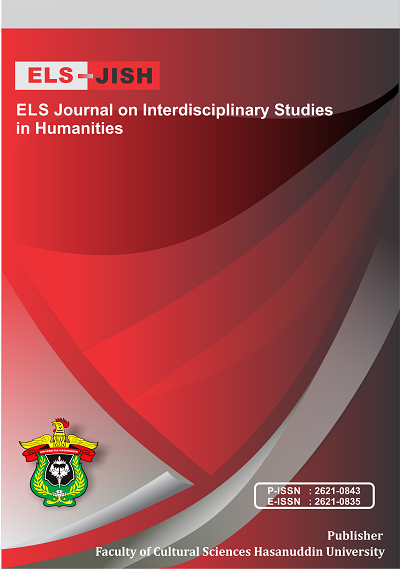Extensive Flouting of Maxim Quantity in Media RRI of Jayapura
DOI:
https://doi.org/10.34050/elsjish.v5i2.21300Keywords:
Flouting, Humor, Maxim Quantity, RRIAbstract
Language is framed in many forms and functions. Flouting is one way to convey idea by deviating rule of communication named maxims that have been proposed by theorists before. The purpose of this study is to investigate the richness of language features used by the people of Papua in interacting ideas throughout TOB-CER program in RRI. The method used in this study was descriptive qualitative method. The procedures used to collect data were recording and selecting. Data was recorded for total seven nights and then selected the familiar topics by considering the distribution of woman and man broadcasters. The data then was transcribed into written forms. The reduction is needed to pick the needed text and then indexed the deviation of maxim quantity into the table. The collections of maxim quantity were analyze by using flouting as its benchmark. The results of this study showed that flouting of maxim quantity is usually used in telling joke and text of intertextuality. The features of telling joke/humor are to release tensions, holding friendship relations as aspect of humanity. Meanwhile, the intertextuality text is featured with measuring understanding and general status such as identity and power. The reasons to express all this flouting are to establish friendship, harmony and to grow the sense of belonging toward the existence of RRI as historical media communication in Papua.
References
Amianna, J.N.R.P., & Putranti, A. (2017). Humorous Situations Created by Violations and Floutings of Conversational Maxims in a Situation Comedy Entitled How I Met Your Mother. Journal of Language and Literature ISSN: 1410-5691 (print); 2580-5878, 17 (1)
Attardo, Salvatore. (1994) Linguistic Theory of Humor. Berlin and New York: Mouton de Gruyter,
Chiaro, D. (1992). The Language of Jokes: Analyzing Verbal Play. London and New York: Routledge.
Cutting, J. (2002). Pragmatics and Discourse: A Resource Book for Students. London: Routledge.
Fahmi, R. (2016). An Analysis of Grice’s Maxims Violation in Daily Conversation. Journal of Languages and Language Teaching, Vol. 4 No.2.
Grice H.P. (1975). Logic and Conversation. In P. Cole, & J. Morgan (Eds), Speech Acts, New York: Academic Press.
Gustary, D.T., & Dikramdhanie, M. (2018). The Analysis of Flouting Maxim in Mata Najwa’s Talkshow ‘GengsiMerebutKursi’. BIORMATIKA JurnalIlmiah FKIP Universitas Subang ISSN (p) 2461-3961 (e) 2580-6335. Vol. 4 No (2)
Hanifah I.R. (2013). Non-Observance of Maxims in Facebook Conversation (A Case Study in English Education Department). Indonesia University. Passage2013,1(2)135-144.
Holmes, J., & Marra, M. (2002). “Over the Edge? Subversive Humor between Colleagues and Friends”. Humor, 15 (1), 65-87.
Kabanga’, L. (2016). Maxims Deviation in Conversation between Domestic Tour Guides and Tourist in Tourisms Spots in Tana-Toraja. A Thesis. Hasanuddin University, Makassar Indonesia.
Kabanga’, L., Moruk, Y., & Hanum, U. L. (2021). Expressive Act by Elite Politicians in Responding Issue of “Coup d’etat” in Democratic Party”. ELS Journal on Interdisciplinary Studies in Humanities, 4(1), 65-74. https://doi.org/10.34050/elsjish.v4i1.13362
Kabanga’, L., & Paranoan, E. (2021). The Significances of Signs in Local Riddle of Toraja. ELS Journal on Interdisciplinary Studies in Humanities, 4(2), 139-147. Retrieved from https://journal.unhas.ac.id/index.php/jish/article/view/14014
Kamaruddin. (2016). Discourse Analysis, An Introduction. A Learning Resource for English Learner. Fakultas Pendidikan Bahasa dan Seni IKIP Mataram.
Kristeva, Julia. (1980). Desire in Language: A Semiotic Approach to Language and Art. New York: Columbia University Press.
Lambert, V.A & lambert, C.E. (2012) Qualitative Descriptive Research: An acceptable Design. Pacific Rim International Journal of Nursing Research, 16(4), 255-256.
Leech, G.N. (1989). Principle of Pragmatics. New York. Longman Group Inc.
Ngeget, S. (2017). A Revisit of the Gricean Maxims in Manado Malay Language. Script Journal: Journal of Linguistic and English Teaching, p-ISSN 2477-1880, e-ISSN 2502-6623, 2(2). Available on http://jurnal.fkip-uwgm.ac.id/index.php/Script
Saleh, F., Rahman, F., & Hasyim, M. (2021). Metaphor in the Bugis Language Expression of the Sidenreng Dialectin South Sulawesi. International Journal of Arts and Social Science, 4(1), 312-318.
Seftika. (2015). Flouts of the Maxims in Interview between Barrack Obama and Robin Roberts of ABC News’ “Good Morning America”. JurnalSMART, 1(1),2015 , 1-9.
Thomas, J. (1995). Meaning in interaction: An introduction to pragmatics. Harlow: Pearson Education Ltd.
Tri Hastuti & Taufan Pamungkas. (2014). Pandangan dan Harapan Khalayakterhadap RRI Jayapura: SebuahRisetAudiens. Journal KomuniTi, VI.( 1) 24-41
Weda, S., Atmowardoyo, H., Rahman, F., & Sakti, A. E. F. (2021). Linguistic aspects in intercultural communication (IC) practices at a higher education institution in Indonesia. Eroupean Language Scientific Journal, 14, 2-6.
Widdowson, H.G. (2004). Text, Context, Pretext: Critical Issues in Discourse Analysis. Blackwell Publishing Ltd.
Yule, G. (1996). Pragmatics. Oxford: Oxford University Press.
Downloads
Published
How to Cite
Issue
Section
License
Copyright (c) 2022 Lewi Kabanga, Maryonas Sobe, Yohanes Moruk

This work is licensed under a Creative Commons Attribution-NonCommercial-ShareAlike 4.0 International License.






